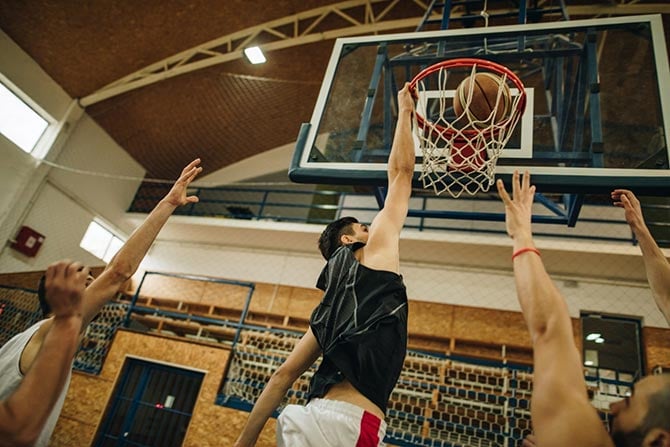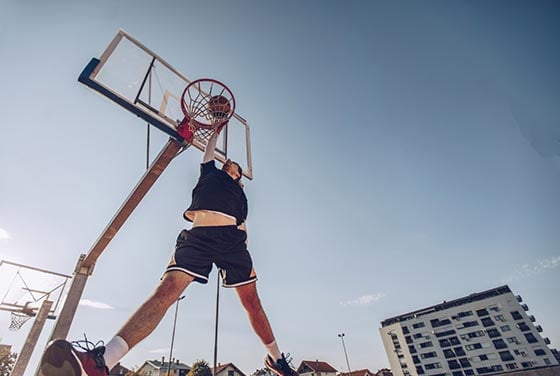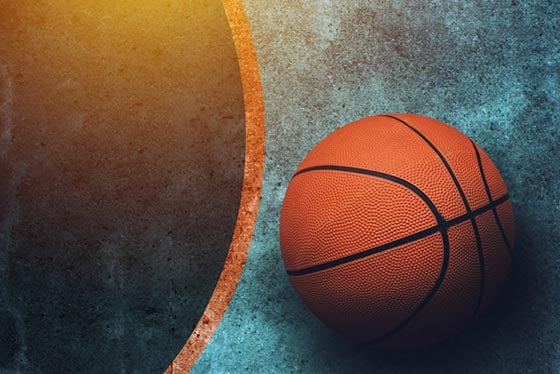Dunking in Basketball
Practice Regimen for the Perfect Slam Dunk

A well executed dunk is the most spectacular way to score in basketball. Not for nothing as not every player is physically able to dunk. In the following article we will tell you what makes a good dunk and how you can learn how to dunk.
Contents:
- What is dunking in basketball?
- What are the advantages of a dunk in basketball?
- Learning to Dunk: How to Master a Slam Dunk
- Train for the slam dunk: Ball handling and jumping power
- Can shorter players learn to dunk?
- Other dunking techniques
- The right jersey for your slam dunk
What is dunking in basketball?
A dunk is a type of basketball shot where a player jumps high enough to "dunk" the ball into the basket. The ball does not leave the player's hand. Officially, this is called a "slam dunk" or "dunking", which is typically shortened to "dunk". The dunk is especially popular in US-based leagues.
Not every player can dunk. After all, the top of the rim is exactly 10 feet (3.05 meters) above the court. Therefore, a successful dunk not only earns the player the adoration of the fans but also his opponents. A player who can dunk is harder to control and can more easily resist block attempts, which makes him an overall more dangerous player.
A successful slam dunk might be a spectacular shot, but just like a regular field goal it is only worth 2 points.
What are the advantages of a slam dunk in basketball?
There are several reasons for basketball players to incorporate dunking into their arsenal. Here are some of them:
- Stronger offense: When performing a successful slam dunk, a player is usually to vault over his opponents block attempts.
- Earn respect: Not every player can dunk. Executing a successful dunk helps you assert your position on the court, fires up your own team and, above all, intimates the opposing team.
- More varied offense: Learning how to dunk can teach you new movement patterns which ultimately results in a more varied offense.
Learning to Dunk: How to Master a Slam Dunk
If you want to learn how to slam dunk, here are a few pointers to keep in mind:
Practice with a lowered basket
When you first start training for a slam dunk, practising with a lowered basket can be a great tool. You will see results more quickly and you can progress more easily by raising the basket bit by bit until you reach the typical basket height of 10 feet (3.05m).

Adjust ball size
A smaller basketball can also help you learn how to dunk. As a smaller ball is easier to handle and control, you can better focus on the jump itself.
It is best to only use a smaller ball for pure dunk training so that you don't get used to the smaller version. If you succeed in dunking with it, you should gradually work your way up to a normal basketball size.
Perform a one-handed slam dunk
Although slam dunks performed with both hands on the ball are frequently seen, players usually only manage this at an advanced stage. It is therefore recommended that you first try to perform the slam dunk with one hand. If you succeed, you can then work on executing the dunk with both hands.
Correct jumping technique
Some players prefer to jump off of one foot while others use both feet. There are no set rules so go with what's more comfortable for you. This can change depending on your age, weight and build. The most important question for you should be which technique lets you jump higher. When training for a slam dunk go with your personal preference. The following guidelines might help you with that.
One-foot jump
With this technique you are only in contact with the ground for a very short time and your active leg has to quickly generate a lot of force to lift up your entire body. The lower your body weight, the higher you are able to jump. Therefore, jumping off of one foot is usually more suited for lighter, leaner and faster players.
Advantages:
- Stronger offense: This technique makes slam dunks harder to block.
- Practicability: This technique is easy to integrate into your game as the sequence of steps is similar to a traditional lay-up.
- Cover more distance: This technique not only allows you to jump high but also further than when you jump with both feet.
Disadvantages:
- Requires stronger ball handling: When using this jumping technique, the slam dunk is usually executed with one arm. This requires excellent ball handling in order to not lose the ball.
- Impact on knees: Only one leg has to generate enough force to lift your entire body up. As you are only in contact with the ground for a short period of time, you can not generate this force from your hips, leaving all the work to your knees.

Jumping with both feet
When jumping with both feet, you are in contact with the ground for much longer. This leaves enough time for your leg and hip muscles to generate power for the jump. Jumping with both feet is therefore more suitable for stronger players.
Advantages:
- It's showtime: Players who use this technique are often able to dunk from a standing position which earns them admiration and respect.
- Act fast: Players who use this technique don't need a lot of preparation time as it can be executed from a standing position.
- Easy on the joints:This technique has a lower risk of injury as the jumping force is generated from the muscles putting less stress on the joints.
Disadvantages:
- Easier to defend: This technique requires a slightly longer wind-up time, which gives the defender more time to react.
- Harder to execute: This technique is harder to execute from a run as it requires one more step than a regular lay-up.
Tip: Older players are generally advised to jump with both feet as this requires less flexibility. As muscles tend to stiffen up the older you get, jumping with both feet brings less risk of injury compared to jumping with one foot.
Train for the slam dunk: Ball handling and jumping power
A successful slam dunk depends above all on ball handling and jumping power. We present suitable exercises.
Practicing ball handling
Your slam dunk technique is only as good as your ball handling. While you are in the air, your arm is extended. Maintaining full control over the ball at this point is paramount to successful completion of the slam dunk basketball manoeuvre.
In this video you will learn how to effectively train and improve your ball handling:
Build up bounce for dunking: Exercises
When building up your jumping power, it is important that you strengthen your hip and leg muscles in particular. This is because they play a key role in providing strength for the jump. Exercises such as squats, lunges or weight training are effective. The following video shows you various exercises that you can use to build up more strength for your slam dunk:
Can shorter players learn to dunk?
Most players who succeed in dunking usually have one of the following two prerequisites:
Both attributes can help you achieve a slam dunk. The most important factor, however, is a player's jumping power. Therefore, shorter players can also learn to dunk. A lower bodyweight can certainly help you with this.
Legendary: The dunk of death
At the 2000 Summer Olympic Games 6'6"(1.98 m) tall Vince Carter managed to jump over the 7'2" (2.18 m) tall center of the French national team, Frédéric Weis and ferociously dunked the ball. Carter himself is “only” 1.98 m tall. Carters spectacular dunk propelled Team USA on to a 106:94 victory over France, eliminating them from the competition. French media therefore dubbed this dunk „le dunk de la mort“ ("the dunk of death").
Other dunking techniques
Once you have learned the traditional basketball slam dunk, you can also train variations on it, to make it harder for your opponents to block you and earn you even more admiration.
Here are a few examples:
- 360° dunk: For this type of dunk the player rotates 360° in mid air before completing the dunk.
- Reverse dunk: In a reverse dunk, the player turns his back towards the basket in mid air, moves the ball over his head and into the basket.
- Windmill dunk: In this variation, the ball is brought to the abdomen and then the windmill motion is started by moving the ball below the waist according to the length of the player's fully extended arm. Then following the rotation of the outstretch arm, the ball is moved in a circular motion, typically moving from the front towards the back, and then slammed through the rim.
- Between the legs slam: From a run, the player jumps with one foot and raises the other leg. While airborne, they transfer the ball from one hand to the other beneath the raised leg before completing the dunk.
- Backscratcher:During the jump, the ball is raised above, and often behind the player's head for a wind-up before slamming the ball down into the net at the apex of the jump. The one-handed version of this move is known as a "tomahawk".
The right jersey for your offensive basketball slam (dunk) maneuver
Whether you can do a slam dunk or not, you always need the right jersey when playing basketball! Our online shop lets you create your very own basketball jersey design. Open our 3D Kit Designer and start designing the jersey or shootinghirt of your dreams right away. By the way, we also offer quantity discounts when ordering for a full team.
If you would like to inspect the quality of our products first, we would be happy to send you free info material or sizing samples. Get in contact with us right now, we are looking forward to hearing from you!
You might also like:
Photo credits: Title picture: gettyimages/skynesher, Picture 2: gettyimages/South_agency, Picture 3: gettyimages/stevanovicigor.

